Leadership, Management, and Operations: A Starbucks Analysis
VerifiedAdded on 2020/06/06
|15
|3538
|32
Report
AI Summary
This report provides a comprehensive analysis of leadership and management practices within Starbucks. It explores the distinct roles of managers and leaders, highlighting their responsibilities in implementing policies, providing training, and building teams. The report differentiates between the functions of a leader and a manager and analyzes the application of these roles in various scenarios, such as customer relations, employee development, and societal impact. It also examines different leadership theories, including system, contingency, and situational leadership, along with their strengths and weaknesses. Furthermore, the report delves into key approaches of operations management, such as Total Quality Management (TQM), Just-in-Time, Lean Production, and Continuous Improvement, illustrating how these methods contribute to achieving business objectives and improving operational efficiency. The report concludes with an evaluation of the factors impacting operational management within Starbucks, offering valuable insights into the company's strategic approach.
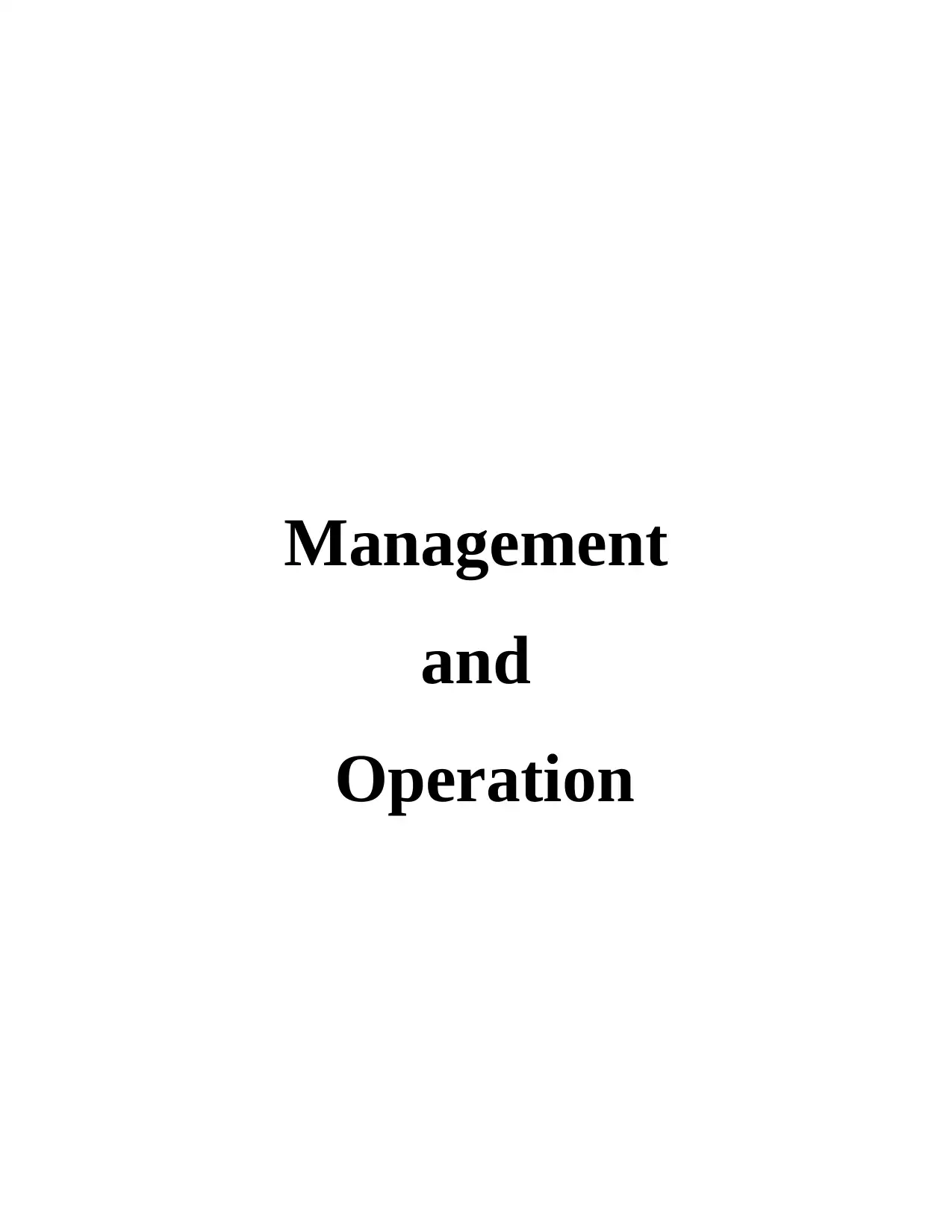
Management
and
Operation
and
Operation
Paraphrase This Document
Need a fresh take? Get an instant paraphrase of this document with our AI Paraphraser

Table of Contents
INTRODUCTION...........................................................................................................................1
PROJECT 1......................................................................................................................................1
TASK 1............................................................................................................................................1
P1. Various roles and characteristics of a manager and leader...................................................1
M1 Differentiate between roles and functions of a leader and manager.....................................2
TASK 2............................................................................................................................................3
P2: Application of role of a leader and function of a manager in various situations..................3
P3: Apply various methods and theories including situational leadership.................................4
M2: Strengths and weaknesses of various approaches...............................................................5
D1: Analyse and evaluate various approaches and theories to leadership..................................5
PROJECT 2......................................................................................................................................5
TASK 1............................................................................................................................................5
P4: Key approaches of operations management and role of managers and leaders....................5
P5: Importance and value of operations management in achieving business objectives............7
M3: Managers and leader can improve efficiencies of operational management.......................8
TASK 2............................................................................................................................................8
P6: Factors in which Starbucks operates that impact operational management.........................8
M4: Factors which affect business operations and decision making process...........................10
D2: Application of operations management.............................................................................10
CONCLUSION..............................................................................................................................10
REFERENCES..............................................................................................................................11
INTRODUCTION...........................................................................................................................1
PROJECT 1......................................................................................................................................1
TASK 1............................................................................................................................................1
P1. Various roles and characteristics of a manager and leader...................................................1
M1 Differentiate between roles and functions of a leader and manager.....................................2
TASK 2............................................................................................................................................3
P2: Application of role of a leader and function of a manager in various situations..................3
P3: Apply various methods and theories including situational leadership.................................4
M2: Strengths and weaknesses of various approaches...............................................................5
D1: Analyse and evaluate various approaches and theories to leadership..................................5
PROJECT 2......................................................................................................................................5
TASK 1............................................................................................................................................5
P4: Key approaches of operations management and role of managers and leaders....................5
P5: Importance and value of operations management in achieving business objectives............7
M3: Managers and leader can improve efficiencies of operational management.......................8
TASK 2............................................................................................................................................8
P6: Factors in which Starbucks operates that impact operational management.........................8
M4: Factors which affect business operations and decision making process...........................10
D2: Application of operations management.............................................................................10
CONCLUSION..............................................................................................................................10
REFERENCES..............................................................................................................................11

⊘ This is a preview!⊘
Do you want full access?
Subscribe today to unlock all pages.

Trusted by 1+ million students worldwide
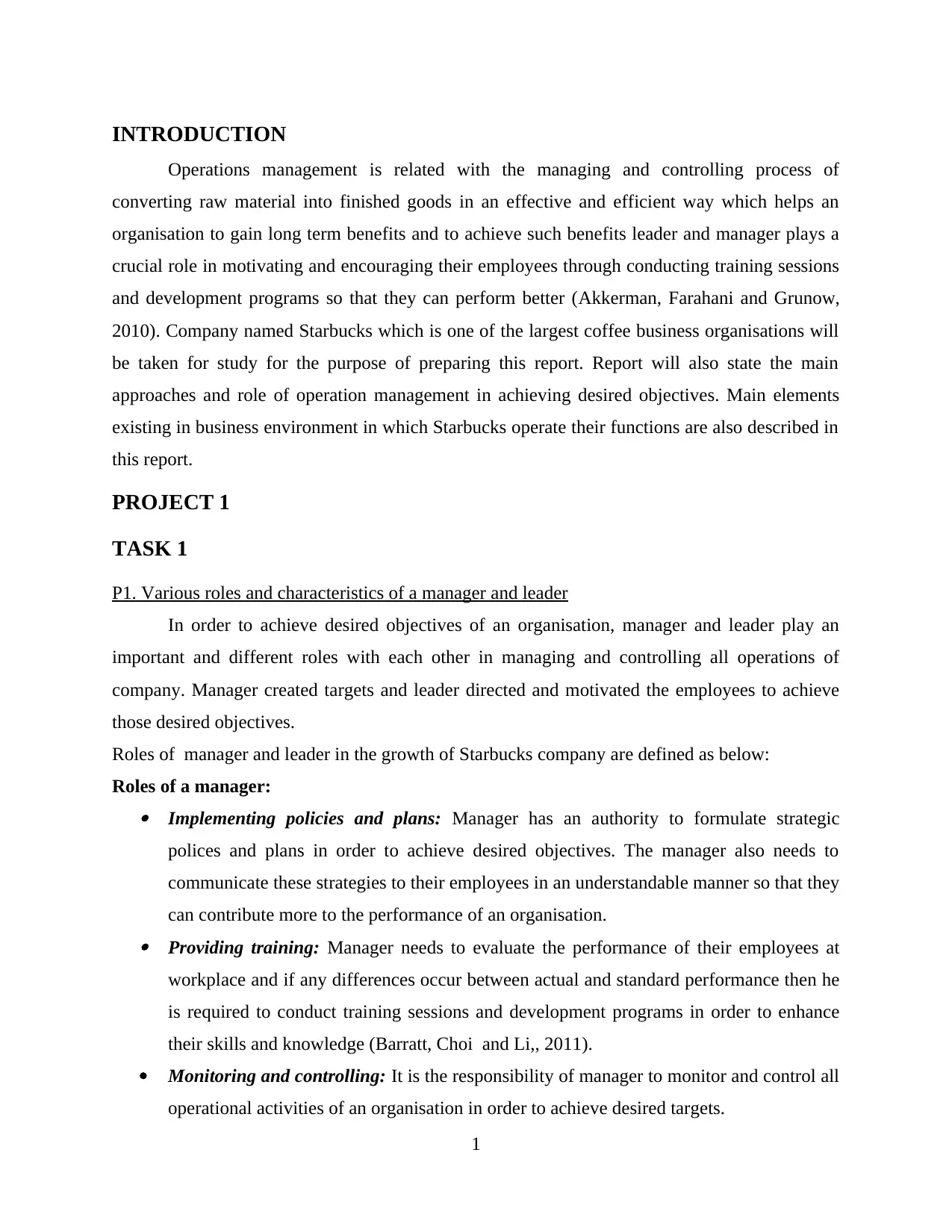
INTRODUCTION
Operations management is related with the managing and controlling process of
converting raw material into finished goods in an effective and efficient way which helps an
organisation to gain long term benefits and to achieve such benefits leader and manager plays a
crucial role in motivating and encouraging their employees through conducting training sessions
and development programs so that they can perform better (Akkerman, Farahani and Grunow,
2010). Company named Starbucks which is one of the largest coffee business organisations will
be taken for study for the purpose of preparing this report. Report will also state the main
approaches and role of operation management in achieving desired objectives. Main elements
existing in business environment in which Starbucks operate their functions are also described in
this report.
PROJECT 1
TASK 1
P1. Various roles and characteristics of a manager and leader
In order to achieve desired objectives of an organisation, manager and leader play an
important and different roles with each other in managing and controlling all operations of
company. Manager created targets and leader directed and motivated the employees to achieve
those desired objectives.
Roles of manager and leader in the growth of Starbucks company are defined as below:
Roles of a manager: Implementing policies and plans: Manager has an authority to formulate strategic
polices and plans in order to achieve desired objectives. The manager also needs to
communicate these strategies to their employees in an understandable manner so that they
can contribute more to the performance of an organisation. Providing training: Manager needs to evaluate the performance of their employees at
workplace and if any differences occur between actual and standard performance then he
is required to conduct training sessions and development programs in order to enhance
their skills and knowledge (Barratt, Choi and Li,, 2011).
Monitoring and controlling: It is the responsibility of manager to monitor and control all
operational activities of an organisation in order to achieve desired targets.
1
Operations management is related with the managing and controlling process of
converting raw material into finished goods in an effective and efficient way which helps an
organisation to gain long term benefits and to achieve such benefits leader and manager plays a
crucial role in motivating and encouraging their employees through conducting training sessions
and development programs so that they can perform better (Akkerman, Farahani and Grunow,
2010). Company named Starbucks which is one of the largest coffee business organisations will
be taken for study for the purpose of preparing this report. Report will also state the main
approaches and role of operation management in achieving desired objectives. Main elements
existing in business environment in which Starbucks operate their functions are also described in
this report.
PROJECT 1
TASK 1
P1. Various roles and characteristics of a manager and leader
In order to achieve desired objectives of an organisation, manager and leader play an
important and different roles with each other in managing and controlling all operations of
company. Manager created targets and leader directed and motivated the employees to achieve
those desired objectives.
Roles of manager and leader in the growth of Starbucks company are defined as below:
Roles of a manager: Implementing policies and plans: Manager has an authority to formulate strategic
polices and plans in order to achieve desired objectives. The manager also needs to
communicate these strategies to their employees in an understandable manner so that they
can contribute more to the performance of an organisation. Providing training: Manager needs to evaluate the performance of their employees at
workplace and if any differences occur between actual and standard performance then he
is required to conduct training sessions and development programs in order to enhance
their skills and knowledge (Barratt, Choi and Li,, 2011).
Monitoring and controlling: It is the responsibility of manager to monitor and control all
operational activities of an organisation in order to achieve desired targets.
1
Paraphrase This Document
Need a fresh take? Get an instant paraphrase of this document with our AI Paraphraser
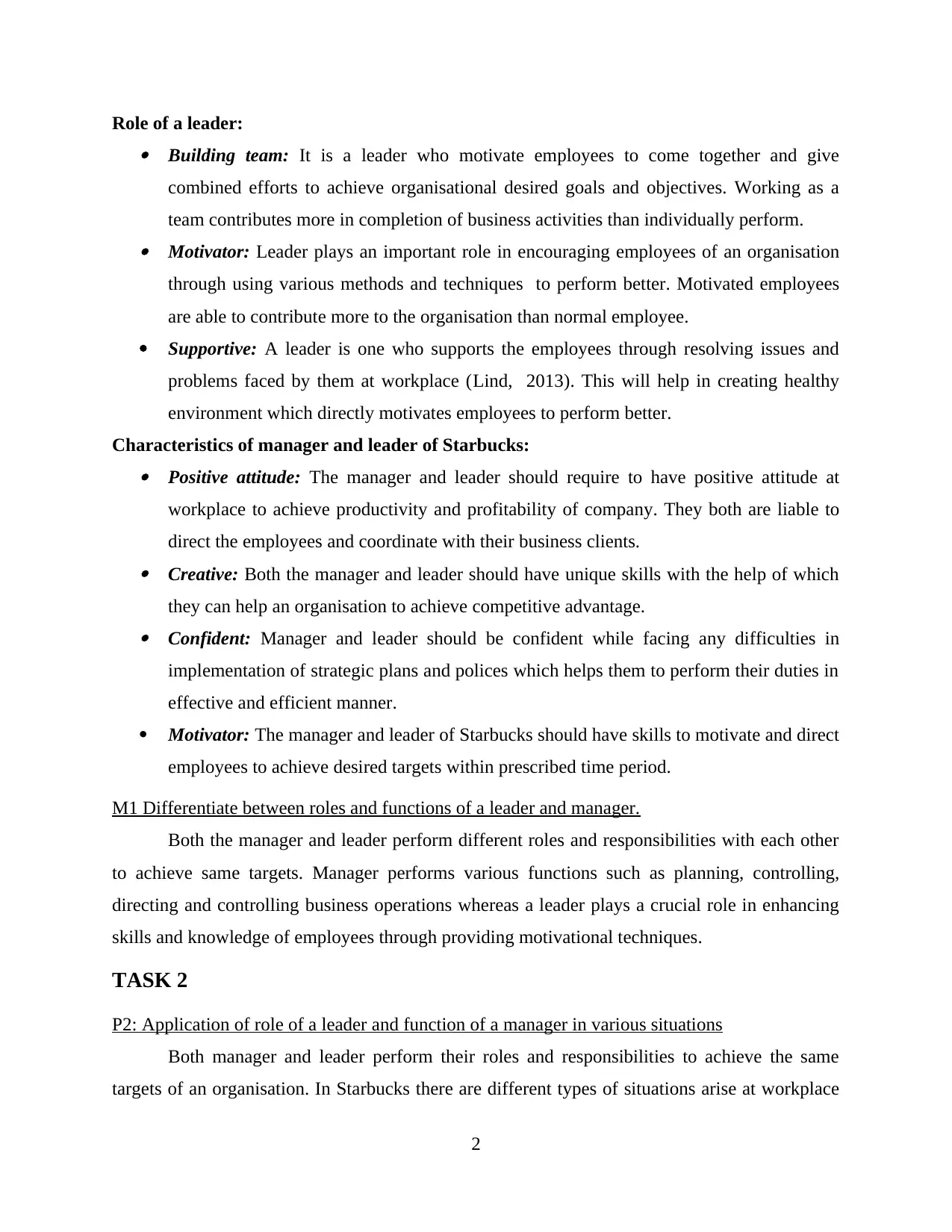
Role of a leader: Building team: It is a leader who motivate employees to come together and give
combined efforts to achieve organisational desired goals and objectives. Working as a
team contributes more in completion of business activities than individually perform. Motivator: Leader plays an important role in encouraging employees of an organisation
through using various methods and techniques to perform better. Motivated employees
are able to contribute more to the organisation than normal employee.
Supportive: A leader is one who supports the employees through resolving issues and
problems faced by them at workplace (Lind, 2013). This will help in creating healthy
environment which directly motivates employees to perform better.
Characteristics of manager and leader of Starbucks: Positive attitude: The manager and leader should require to have positive attitude at
workplace to achieve productivity and profitability of company. They both are liable to
direct the employees and coordinate with their business clients. Creative: Both the manager and leader should have unique skills with the help of which
they can help an organisation to achieve competitive advantage. Confident: Manager and leader should be confident while facing any difficulties in
implementation of strategic plans and polices which helps them to perform their duties in
effective and efficient manner.
Motivator: The manager and leader of Starbucks should have skills to motivate and direct
employees to achieve desired targets within prescribed time period.
M1 Differentiate between roles and functions of a leader and manager.
Both the manager and leader perform different roles and responsibilities with each other
to achieve same targets. Manager performs various functions such as planning, controlling,
directing and controlling business operations whereas a leader plays a crucial role in enhancing
skills and knowledge of employees through providing motivational techniques.
TASK 2
P2: Application of role of a leader and function of a manager in various situations
Both manager and leader perform their roles and responsibilities to achieve the same
targets of an organisation. In Starbucks there are different types of situations arise at workplace
2
combined efforts to achieve organisational desired goals and objectives. Working as a
team contributes more in completion of business activities than individually perform. Motivator: Leader plays an important role in encouraging employees of an organisation
through using various methods and techniques to perform better. Motivated employees
are able to contribute more to the organisation than normal employee.
Supportive: A leader is one who supports the employees through resolving issues and
problems faced by them at workplace (Lind, 2013). This will help in creating healthy
environment which directly motivates employees to perform better.
Characteristics of manager and leader of Starbucks: Positive attitude: The manager and leader should require to have positive attitude at
workplace to achieve productivity and profitability of company. They both are liable to
direct the employees and coordinate with their business clients. Creative: Both the manager and leader should have unique skills with the help of which
they can help an organisation to achieve competitive advantage. Confident: Manager and leader should be confident while facing any difficulties in
implementation of strategic plans and polices which helps them to perform their duties in
effective and efficient manner.
Motivator: The manager and leader of Starbucks should have skills to motivate and direct
employees to achieve desired targets within prescribed time period.
M1 Differentiate between roles and functions of a leader and manager.
Both the manager and leader perform different roles and responsibilities with each other
to achieve same targets. Manager performs various functions such as planning, controlling,
directing and controlling business operations whereas a leader plays a crucial role in enhancing
skills and knowledge of employees through providing motivational techniques.
TASK 2
P2: Application of role of a leader and function of a manager in various situations
Both manager and leader perform their roles and responsibilities to achieve the same
targets of an organisation. In Starbucks there are different types of situations arise at workplace
2
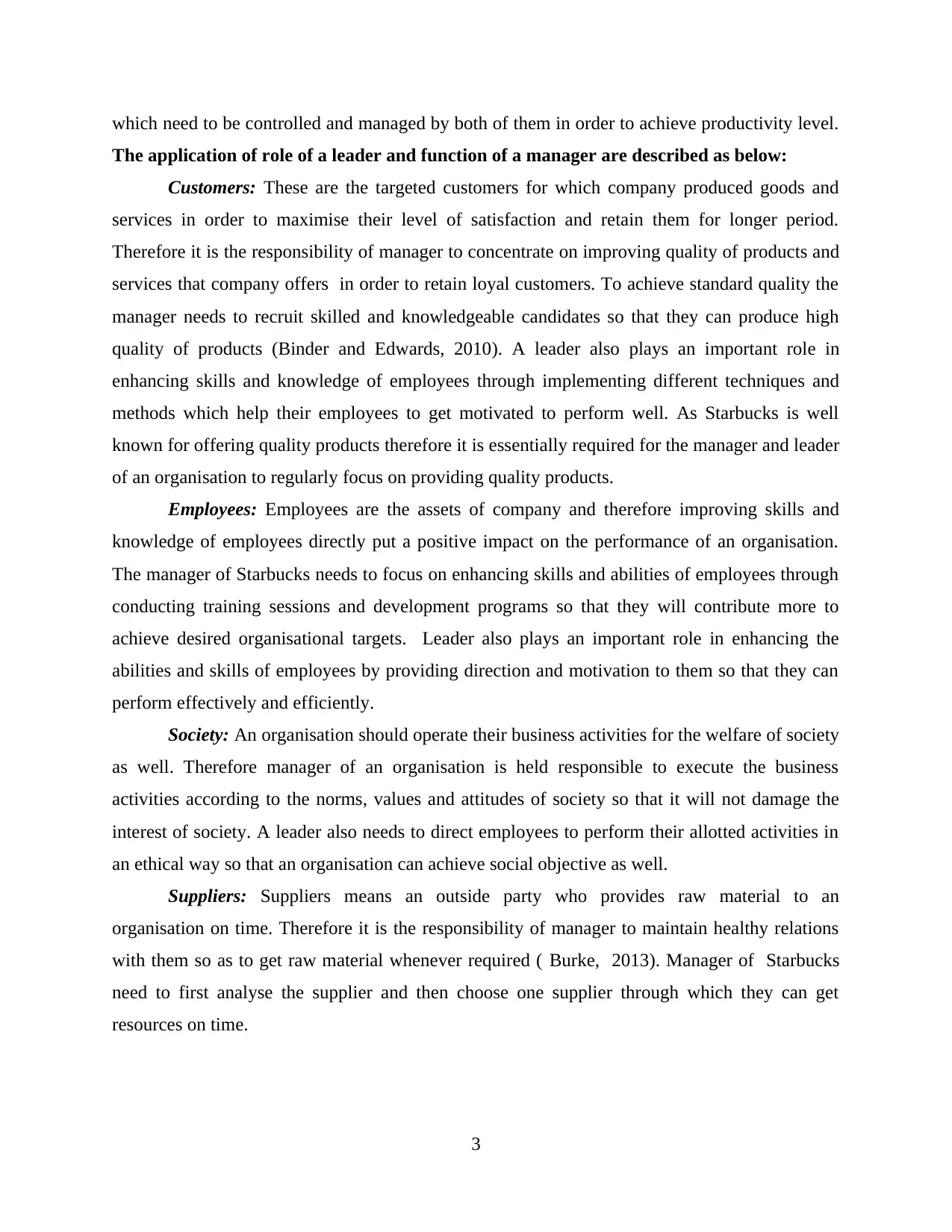
which need to be controlled and managed by both of them in order to achieve productivity level.
The application of role of a leader and function of a manager are described as below:
Customers: These are the targeted customers for which company produced goods and
services in order to maximise their level of satisfaction and retain them for longer period.
Therefore it is the responsibility of manager to concentrate on improving quality of products and
services that company offers in order to retain loyal customers. To achieve standard quality the
manager needs to recruit skilled and knowledgeable candidates so that they can produce high
quality of products (Binder and Edwards, 2010). A leader also plays an important role in
enhancing skills and knowledge of employees through implementing different techniques and
methods which help their employees to get motivated to perform well. As Starbucks is well
known for offering quality products therefore it is essentially required for the manager and leader
of an organisation to regularly focus on providing quality products.
Employees: Employees are the assets of company and therefore improving skills and
knowledge of employees directly put a positive impact on the performance of an organisation.
The manager of Starbucks needs to focus on enhancing skills and abilities of employees through
conducting training sessions and development programs so that they will contribute more to
achieve desired organisational targets. Leader also plays an important role in enhancing the
abilities and skills of employees by providing direction and motivation to them so that they can
perform effectively and efficiently.
Society: An organisation should operate their business activities for the welfare of society
as well. Therefore manager of an organisation is held responsible to execute the business
activities according to the norms, values and attitudes of society so that it will not damage the
interest of society. A leader also needs to direct employees to perform their allotted activities in
an ethical way so that an organisation can achieve social objective as well.
Suppliers: Suppliers means an outside party who provides raw material to an
organisation on time. Therefore it is the responsibility of manager to maintain healthy relations
with them so as to get raw material whenever required ( Burke, 2013). Manager of Starbucks
need to first analyse the supplier and then choose one supplier through which they can get
resources on time.
3
The application of role of a leader and function of a manager are described as below:
Customers: These are the targeted customers for which company produced goods and
services in order to maximise their level of satisfaction and retain them for longer period.
Therefore it is the responsibility of manager to concentrate on improving quality of products and
services that company offers in order to retain loyal customers. To achieve standard quality the
manager needs to recruit skilled and knowledgeable candidates so that they can produce high
quality of products (Binder and Edwards, 2010). A leader also plays an important role in
enhancing skills and knowledge of employees through implementing different techniques and
methods which help their employees to get motivated to perform well. As Starbucks is well
known for offering quality products therefore it is essentially required for the manager and leader
of an organisation to regularly focus on providing quality products.
Employees: Employees are the assets of company and therefore improving skills and
knowledge of employees directly put a positive impact on the performance of an organisation.
The manager of Starbucks needs to focus on enhancing skills and abilities of employees through
conducting training sessions and development programs so that they will contribute more to
achieve desired organisational targets. Leader also plays an important role in enhancing the
abilities and skills of employees by providing direction and motivation to them so that they can
perform effectively and efficiently.
Society: An organisation should operate their business activities for the welfare of society
as well. Therefore manager of an organisation is held responsible to execute the business
activities according to the norms, values and attitudes of society so that it will not damage the
interest of society. A leader also needs to direct employees to perform their allotted activities in
an ethical way so that an organisation can achieve social objective as well.
Suppliers: Suppliers means an outside party who provides raw material to an
organisation on time. Therefore it is the responsibility of manager to maintain healthy relations
with them so as to get raw material whenever required ( Burke, 2013). Manager of Starbucks
need to first analyse the supplier and then choose one supplier through which they can get
resources on time.
3
⊘ This is a preview!⊘
Do you want full access?
Subscribe today to unlock all pages.

Trusted by 1+ million students worldwide
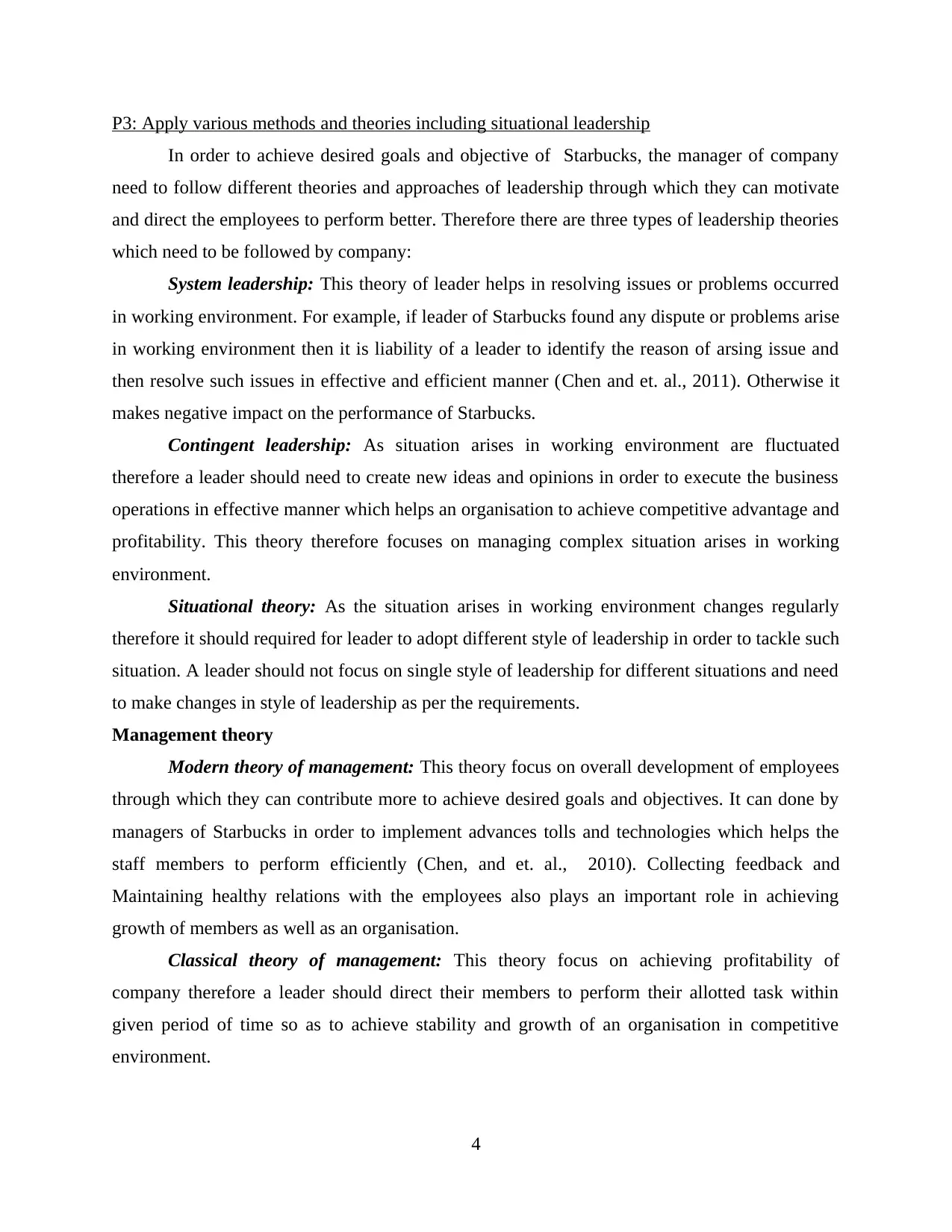
P3: Apply various methods and theories including situational leadership
In order to achieve desired goals and objective of Starbucks, the manager of company
need to follow different theories and approaches of leadership through which they can motivate
and direct the employees to perform better. Therefore there are three types of leadership theories
which need to be followed by company:
System leadership: This theory of leader helps in resolving issues or problems occurred
in working environment. For example, if leader of Starbucks found any dispute or problems arise
in working environment then it is liability of a leader to identify the reason of arsing issue and
then resolve such issues in effective and efficient manner (Chen and et. al., 2011). Otherwise it
makes negative impact on the performance of Starbucks.
Contingent leadership: As situation arises in working environment are fluctuated
therefore a leader should need to create new ideas and opinions in order to execute the business
operations in effective manner which helps an organisation to achieve competitive advantage and
profitability. This theory therefore focuses on managing complex situation arises in working
environment.
Situational theory: As the situation arises in working environment changes regularly
therefore it should required for leader to adopt different style of leadership in order to tackle such
situation. A leader should not focus on single style of leadership for different situations and need
to make changes in style of leadership as per the requirements.
Management theory
Modern theory of management: This theory focus on overall development of employees
through which they can contribute more to achieve desired goals and objectives. It can done by
managers of Starbucks in order to implement advances tolls and technologies which helps the
staff members to perform efficiently (Chen, and et. al., 2010). Collecting feedback and
Maintaining healthy relations with the employees also plays an important role in achieving
growth of members as well as an organisation.
Classical theory of management: This theory focus on achieving profitability of
company therefore a leader should direct their members to perform their allotted task within
given period of time so as to achieve stability and growth of an organisation in competitive
environment.
4
In order to achieve desired goals and objective of Starbucks, the manager of company
need to follow different theories and approaches of leadership through which they can motivate
and direct the employees to perform better. Therefore there are three types of leadership theories
which need to be followed by company:
System leadership: This theory of leader helps in resolving issues or problems occurred
in working environment. For example, if leader of Starbucks found any dispute or problems arise
in working environment then it is liability of a leader to identify the reason of arsing issue and
then resolve such issues in effective and efficient manner (Chen and et. al., 2011). Otherwise it
makes negative impact on the performance of Starbucks.
Contingent leadership: As situation arises in working environment are fluctuated
therefore a leader should need to create new ideas and opinions in order to execute the business
operations in effective manner which helps an organisation to achieve competitive advantage and
profitability. This theory therefore focuses on managing complex situation arises in working
environment.
Situational theory: As the situation arises in working environment changes regularly
therefore it should required for leader to adopt different style of leadership in order to tackle such
situation. A leader should not focus on single style of leadership for different situations and need
to make changes in style of leadership as per the requirements.
Management theory
Modern theory of management: This theory focus on overall development of employees
through which they can contribute more to achieve desired goals and objectives. It can done by
managers of Starbucks in order to implement advances tolls and technologies which helps the
staff members to perform efficiently (Chen, and et. al., 2010). Collecting feedback and
Maintaining healthy relations with the employees also plays an important role in achieving
growth of members as well as an organisation.
Classical theory of management: This theory focus on achieving profitability of
company therefore a leader should direct their members to perform their allotted task within
given period of time so as to achieve stability and growth of an organisation in competitive
environment.
4
Paraphrase This Document
Need a fresh take? Get an instant paraphrase of this document with our AI Paraphraser
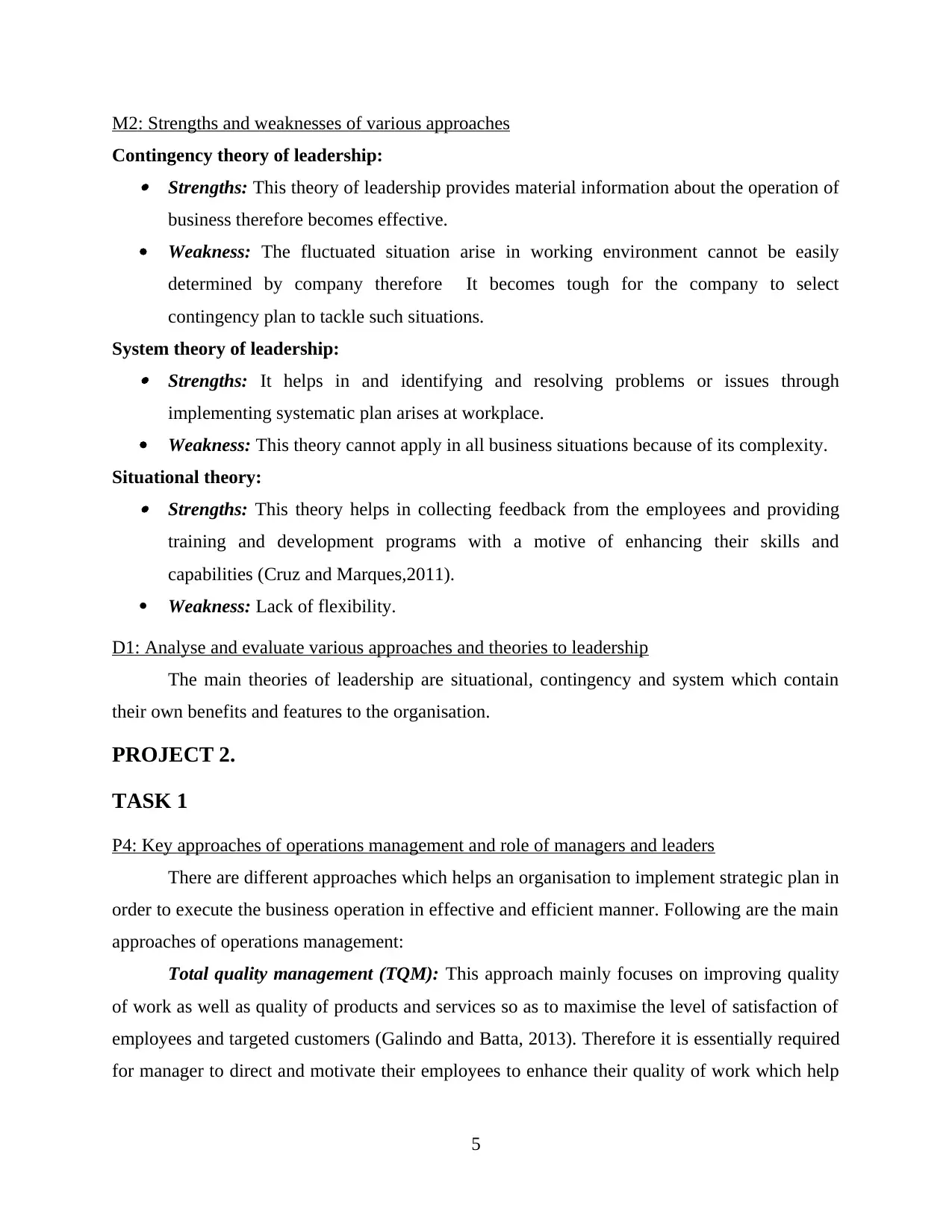
M2: Strengths and weaknesses of various approaches
Contingency theory of leadership: Strengths: This theory of leadership provides material information about the operation of
business therefore becomes effective.
Weakness: The fluctuated situation arise in working environment cannot be easily
determined by company therefore It becomes tough for the company to select
contingency plan to tackle such situations.
System theory of leadership: Strengths: It helps in and identifying and resolving problems or issues through
implementing systematic plan arises at workplace.
Weakness: This theory cannot apply in all business situations because of its complexity.
Situational theory: Strengths: This theory helps in collecting feedback from the employees and providing
training and development programs with a motive of enhancing their skills and
capabilities (Cruz and Marques,2011).
Weakness: Lack of flexibility.
D1: Analyse and evaluate various approaches and theories to leadership
The main theories of leadership are situational, contingency and system which contain
their own benefits and features to the organisation.
PROJECT 2.
TASK 1
P4: Key approaches of operations management and role of managers and leaders
There are different approaches which helps an organisation to implement strategic plan in
order to execute the business operation in effective and efficient manner. Following are the main
approaches of operations management:
Total quality management (TQM): This approach mainly focuses on improving quality
of work as well as quality of products and services so as to maximise the level of satisfaction of
employees and targeted customers (Galindo and Batta, 2013). Therefore it is essentially required
for manager to direct and motivate their employees to enhance their quality of work which help
5
Contingency theory of leadership: Strengths: This theory of leadership provides material information about the operation of
business therefore becomes effective.
Weakness: The fluctuated situation arise in working environment cannot be easily
determined by company therefore It becomes tough for the company to select
contingency plan to tackle such situations.
System theory of leadership: Strengths: It helps in and identifying and resolving problems or issues through
implementing systematic plan arises at workplace.
Weakness: This theory cannot apply in all business situations because of its complexity.
Situational theory: Strengths: This theory helps in collecting feedback from the employees and providing
training and development programs with a motive of enhancing their skills and
capabilities (Cruz and Marques,2011).
Weakness: Lack of flexibility.
D1: Analyse and evaluate various approaches and theories to leadership
The main theories of leadership are situational, contingency and system which contain
their own benefits and features to the organisation.
PROJECT 2.
TASK 1
P4: Key approaches of operations management and role of managers and leaders
There are different approaches which helps an organisation to implement strategic plan in
order to execute the business operation in effective and efficient manner. Following are the main
approaches of operations management:
Total quality management (TQM): This approach mainly focuses on improving quality
of work as well as quality of products and services so as to maximise the level of satisfaction of
employees and targeted customers (Galindo and Batta, 2013). Therefore it is essentially required
for manager to direct and motivate their employees to enhance their quality of work which help
5
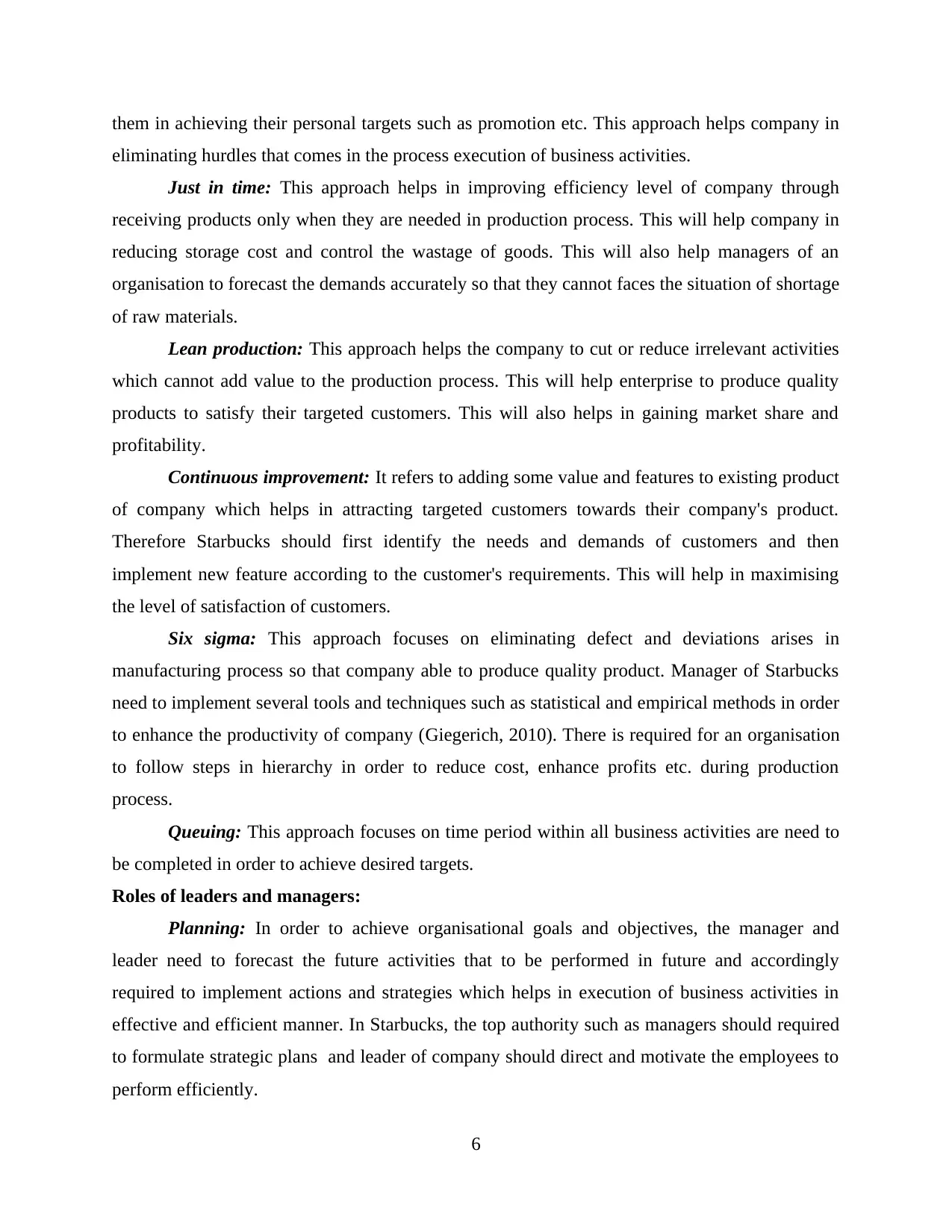
them in achieving their personal targets such as promotion etc. This approach helps company in
eliminating hurdles that comes in the process execution of business activities.
Just in time: This approach helps in improving efficiency level of company through
receiving products only when they are needed in production process. This will help company in
reducing storage cost and control the wastage of goods. This will also help managers of an
organisation to forecast the demands accurately so that they cannot faces the situation of shortage
of raw materials.
Lean production: This approach helps the company to cut or reduce irrelevant activities
which cannot add value to the production process. This will help enterprise to produce quality
products to satisfy their targeted customers. This will also helps in gaining market share and
profitability.
Continuous improvement: It refers to adding some value and features to existing product
of company which helps in attracting targeted customers towards their company's product.
Therefore Starbucks should first identify the needs and demands of customers and then
implement new feature according to the customer's requirements. This will help in maximising
the level of satisfaction of customers.
Six sigma: This approach focuses on eliminating defect and deviations arises in
manufacturing process so that company able to produce quality product. Manager of Starbucks
need to implement several tools and techniques such as statistical and empirical methods in order
to enhance the productivity of company (Giegerich, 2010). There is required for an organisation
to follow steps in hierarchy in order to reduce cost, enhance profits etc. during production
process.
Queuing: This approach focuses on time period within all business activities are need to
be completed in order to achieve desired targets.
Roles of leaders and managers:
Planning: In order to achieve organisational goals and objectives, the manager and
leader need to forecast the future activities that to be performed in future and accordingly
required to implement actions and strategies which helps in execution of business activities in
effective and efficient manner. In Starbucks, the top authority such as managers should required
to formulate strategic plans and leader of company should direct and motivate the employees to
perform efficiently.
6
eliminating hurdles that comes in the process execution of business activities.
Just in time: This approach helps in improving efficiency level of company through
receiving products only when they are needed in production process. This will help company in
reducing storage cost and control the wastage of goods. This will also help managers of an
organisation to forecast the demands accurately so that they cannot faces the situation of shortage
of raw materials.
Lean production: This approach helps the company to cut or reduce irrelevant activities
which cannot add value to the production process. This will help enterprise to produce quality
products to satisfy their targeted customers. This will also helps in gaining market share and
profitability.
Continuous improvement: It refers to adding some value and features to existing product
of company which helps in attracting targeted customers towards their company's product.
Therefore Starbucks should first identify the needs and demands of customers and then
implement new feature according to the customer's requirements. This will help in maximising
the level of satisfaction of customers.
Six sigma: This approach focuses on eliminating defect and deviations arises in
manufacturing process so that company able to produce quality product. Manager of Starbucks
need to implement several tools and techniques such as statistical and empirical methods in order
to enhance the productivity of company (Giegerich, 2010). There is required for an organisation
to follow steps in hierarchy in order to reduce cost, enhance profits etc. during production
process.
Queuing: This approach focuses on time period within all business activities are need to
be completed in order to achieve desired targets.
Roles of leaders and managers:
Planning: In order to achieve organisational goals and objectives, the manager and
leader need to forecast the future activities that to be performed in future and accordingly
required to implement actions and strategies which helps in execution of business activities in
effective and efficient manner. In Starbucks, the top authority such as managers should required
to formulate strategic plans and leader of company should direct and motivate the employees to
perform efficiently.
6
⊘ This is a preview!⊘
Do you want full access?
Subscribe today to unlock all pages.

Trusted by 1+ million students worldwide
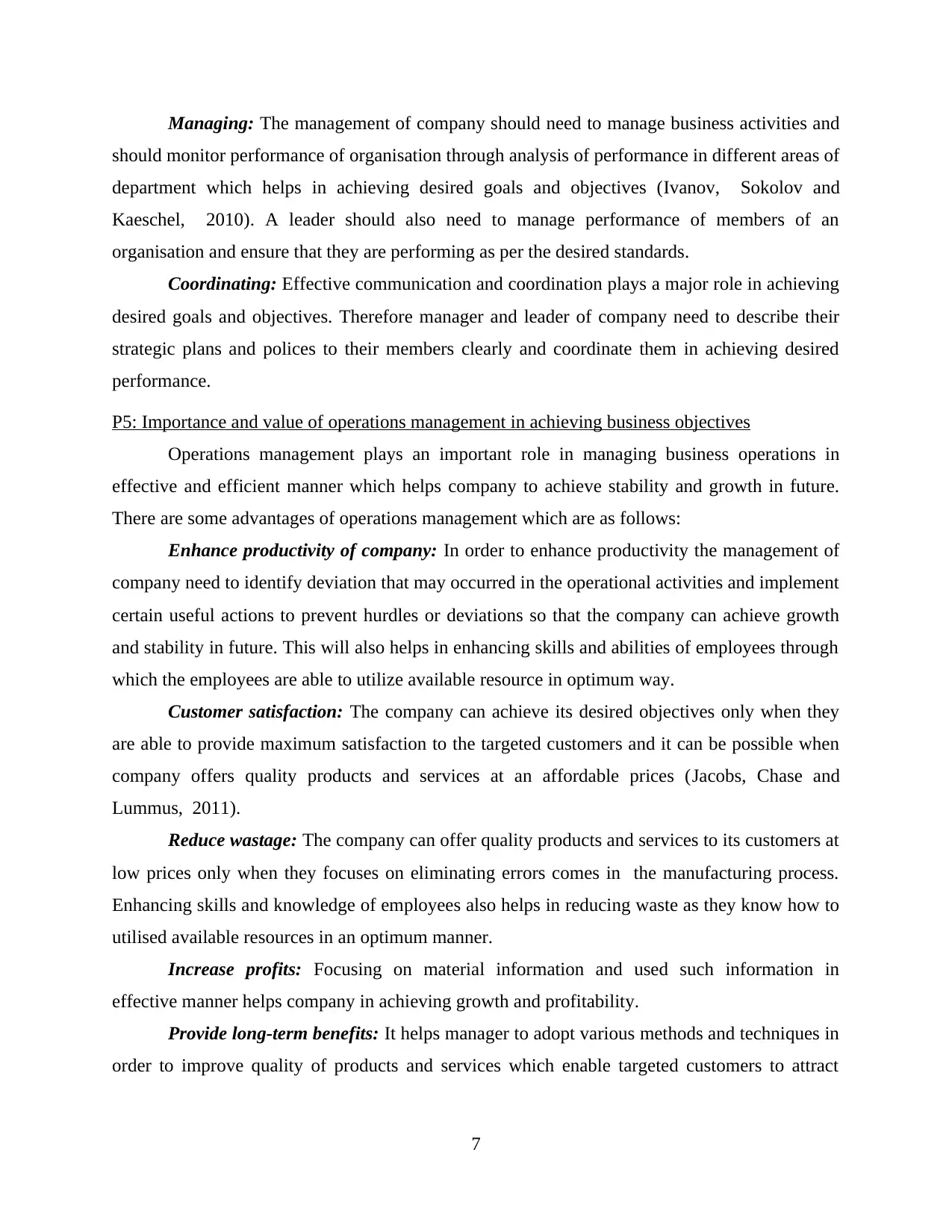
Managing: The management of company should need to manage business activities and
should monitor performance of organisation through analysis of performance in different areas of
department which helps in achieving desired goals and objectives (Ivanov, Sokolov and
Kaeschel, 2010). A leader should also need to manage performance of members of an
organisation and ensure that they are performing as per the desired standards.
Coordinating: Effective communication and coordination plays a major role in achieving
desired goals and objectives. Therefore manager and leader of company need to describe their
strategic plans and polices to their members clearly and coordinate them in achieving desired
performance.
P5: Importance and value of operations management in achieving business objectives
Operations management plays an important role in managing business operations in
effective and efficient manner which helps company to achieve stability and growth in future.
There are some advantages of operations management which are as follows:
Enhance productivity of company: In order to enhance productivity the management of
company need to identify deviation that may occurred in the operational activities and implement
certain useful actions to prevent hurdles or deviations so that the company can achieve growth
and stability in future. This will also helps in enhancing skills and abilities of employees through
which the employees are able to utilize available resource in optimum way.
Customer satisfaction: The company can achieve its desired objectives only when they
are able to provide maximum satisfaction to the targeted customers and it can be possible when
company offers quality products and services at an affordable prices (Jacobs, Chase and
Lummus, 2011).
Reduce wastage: The company can offer quality products and services to its customers at
low prices only when they focuses on eliminating errors comes in the manufacturing process.
Enhancing skills and knowledge of employees also helps in reducing waste as they know how to
utilised available resources in an optimum manner.
Increase profits: Focusing on material information and used such information in
effective manner helps company in achieving growth and profitability.
Provide long-term benefits: It helps manager to adopt various methods and techniques in
order to improve quality of products and services which enable targeted customers to attract
7
should monitor performance of organisation through analysis of performance in different areas of
department which helps in achieving desired goals and objectives (Ivanov, Sokolov and
Kaeschel, 2010). A leader should also need to manage performance of members of an
organisation and ensure that they are performing as per the desired standards.
Coordinating: Effective communication and coordination plays a major role in achieving
desired goals and objectives. Therefore manager and leader of company need to describe their
strategic plans and polices to their members clearly and coordinate them in achieving desired
performance.
P5: Importance and value of operations management in achieving business objectives
Operations management plays an important role in managing business operations in
effective and efficient manner which helps company to achieve stability and growth in future.
There are some advantages of operations management which are as follows:
Enhance productivity of company: In order to enhance productivity the management of
company need to identify deviation that may occurred in the operational activities and implement
certain useful actions to prevent hurdles or deviations so that the company can achieve growth
and stability in future. This will also helps in enhancing skills and abilities of employees through
which the employees are able to utilize available resource in optimum way.
Customer satisfaction: The company can achieve its desired objectives only when they
are able to provide maximum satisfaction to the targeted customers and it can be possible when
company offers quality products and services at an affordable prices (Jacobs, Chase and
Lummus, 2011).
Reduce wastage: The company can offer quality products and services to its customers at
low prices only when they focuses on eliminating errors comes in the manufacturing process.
Enhancing skills and knowledge of employees also helps in reducing waste as they know how to
utilised available resources in an optimum manner.
Increase profits: Focusing on material information and used such information in
effective manner helps company in achieving growth and profitability.
Provide long-term benefits: It helps manager to adopt various methods and techniques in
order to improve quality of products and services which enable targeted customers to attract
7
Paraphrase This Document
Need a fresh take? Get an instant paraphrase of this document with our AI Paraphraser
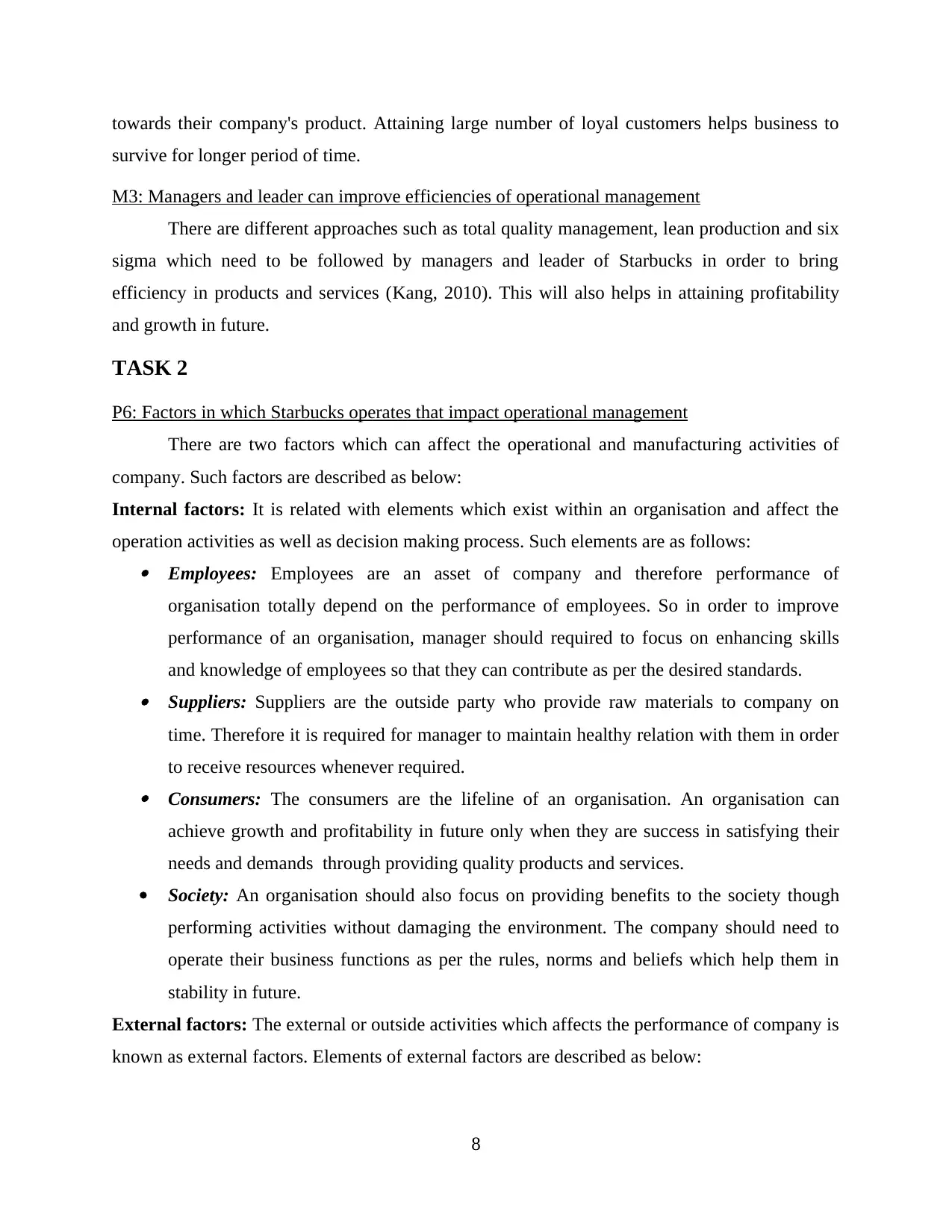
towards their company's product. Attaining large number of loyal customers helps business to
survive for longer period of time.
M3: Managers and leader can improve efficiencies of operational management
There are different approaches such as total quality management, lean production and six
sigma which need to be followed by managers and leader of Starbucks in order to bring
efficiency in products and services (Kang, 2010). This will also helps in attaining profitability
and growth in future.
TASK 2
P6: Factors in which Starbucks operates that impact operational management
There are two factors which can affect the operational and manufacturing activities of
company. Such factors are described as below:
Internal factors: It is related with elements which exist within an organisation and affect the
operation activities as well as decision making process. Such elements are as follows: Employees: Employees are an asset of company and therefore performance of
organisation totally depend on the performance of employees. So in order to improve
performance of an organisation, manager should required to focus on enhancing skills
and knowledge of employees so that they can contribute as per the desired standards. Suppliers: Suppliers are the outside party who provide raw materials to company on
time. Therefore it is required for manager to maintain healthy relation with them in order
to receive resources whenever required. Consumers: The consumers are the lifeline of an organisation. An organisation can
achieve growth and profitability in future only when they are success in satisfying their
needs and demands through providing quality products and services.
Society: An organisation should also focus on providing benefits to the society though
performing activities without damaging the environment. The company should need to
operate their business functions as per the rules, norms and beliefs which help them in
stability in future.
External factors: The external or outside activities which affects the performance of company is
known as external factors. Elements of external factors are described as below:
8
survive for longer period of time.
M3: Managers and leader can improve efficiencies of operational management
There are different approaches such as total quality management, lean production and six
sigma which need to be followed by managers and leader of Starbucks in order to bring
efficiency in products and services (Kang, 2010). This will also helps in attaining profitability
and growth in future.
TASK 2
P6: Factors in which Starbucks operates that impact operational management
There are two factors which can affect the operational and manufacturing activities of
company. Such factors are described as below:
Internal factors: It is related with elements which exist within an organisation and affect the
operation activities as well as decision making process. Such elements are as follows: Employees: Employees are an asset of company and therefore performance of
organisation totally depend on the performance of employees. So in order to improve
performance of an organisation, manager should required to focus on enhancing skills
and knowledge of employees so that they can contribute as per the desired standards. Suppliers: Suppliers are the outside party who provide raw materials to company on
time. Therefore it is required for manager to maintain healthy relation with them in order
to receive resources whenever required. Consumers: The consumers are the lifeline of an organisation. An organisation can
achieve growth and profitability in future only when they are success in satisfying their
needs and demands through providing quality products and services.
Society: An organisation should also focus on providing benefits to the society though
performing activities without damaging the environment. The company should need to
operate their business functions as per the rules, norms and beliefs which help them in
stability in future.
External factors: The external or outside activities which affects the performance of company is
known as external factors. Elements of external factors are described as below:
8

Figure 1. PESTLE Analysis, 2017
source: pestleanalysis.com Political factors: It is related with government's rules, standards and legislation that to be
followed by company in order to run successfully. Violation of any rules or standards
bring the company's existence in danger (Mendis, Muttaqi and Perera, 2014). Economic factors: The economic factors which can affect business activities and
economy of country is known as economic factors. Such factors include inflation rate,
deflation rate and interest rate which made impact either negatively or positively on the
business activities. Social factors: Manager should need to take effective decision relating t organisational
activities which cannot damage the environment. The company should act for the welfare
of society through producing healthy products. Technological factors: The company should need to adopt updated advanced technology
which helps in improving efficiency of employees and provide maximum satisfaction to
them. Legal factors: It is related with government's laws and standards which need to
implemented by manager within an organisation. It can also affect decision making
process of an organisation.
Environmental factors: The environmental conditions such as climate, natural hazards
etc. which can affect the operational activities of company.
9
source: pestleanalysis.com Political factors: It is related with government's rules, standards and legislation that to be
followed by company in order to run successfully. Violation of any rules or standards
bring the company's existence in danger (Mendis, Muttaqi and Perera, 2014). Economic factors: The economic factors which can affect business activities and
economy of country is known as economic factors. Such factors include inflation rate,
deflation rate and interest rate which made impact either negatively or positively on the
business activities. Social factors: Manager should need to take effective decision relating t organisational
activities which cannot damage the environment. The company should act for the welfare
of society through producing healthy products. Technological factors: The company should need to adopt updated advanced technology
which helps in improving efficiency of employees and provide maximum satisfaction to
them. Legal factors: It is related with government's laws and standards which need to
implemented by manager within an organisation. It can also affect decision making
process of an organisation.
Environmental factors: The environmental conditions such as climate, natural hazards
etc. which can affect the operational activities of company.
9
⊘ This is a preview!⊘
Do you want full access?
Subscribe today to unlock all pages.

Trusted by 1+ million students worldwide
1 out of 15
Related Documents
Your All-in-One AI-Powered Toolkit for Academic Success.
+13062052269
info@desklib.com
Available 24*7 on WhatsApp / Email
![[object Object]](/_next/static/media/star-bottom.7253800d.svg)
Unlock your academic potential
Copyright © 2020–2025 A2Z Services. All Rights Reserved. Developed and managed by ZUCOL.





